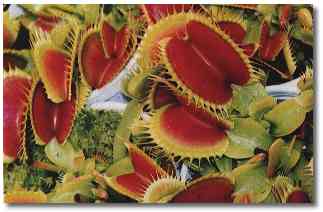 Botanical
name: Dionaea musipula
Botanical
name: Dionaea musipulaHow does it work?
The leaf tip of this plant has developed to form two halves of a trap which,
once shut, is capable of holding a wide variety of insects which are often larger
than the trap itself. The inner surface of the trap is lined with hairs. The
hair is a clever trigger mechanism that must be touched at least twice to activate
the trap. (This is the measure which stops the trap from closing when rubbish
or rain drops fall into the leaves).
Once triggered, a healthy trap will shut in a fraction of a second to trap the
insect. If the triggering of the hairs continues once the trap is shut, the
leaves are held together tighter & the digestive process begins by the plant
releasing an enzymes into the insect. This enzyme slowly dissolves the internal
tissue of the insect which then supplies the plant with food.
If the hair triggers are not touched after the trap is shut, the trap re-opens
within a few hours & be ready for the next insect.
Feeding your trap: We recommend not fertilising your VFTs (Venus Fly Trap).
VFTs do not actually need insects for food. They simply use them as an additional
source of food to supplement the meagre nutrients found in the soils of their
natural habitat. You actually should take care not to overfeed your VFT. Although
over-feeding will not kill the plant, it makes it very soft & weak (from rapid
growth). Over feeding also reduces the size of the trap produces.
Ideal position: An open, sunny position in a nutrient-poor soil. VFTs
occur naturally as a ground cover in open forests areas of Carolina (USA) &
the plants rely on regular natural fires to clear undergrowth which then allows
these plants to get sufficient sunlight to survive.
Note: If grown in the shade, the red pigment of 'Big Mouth' is much reduced.
Climates: VFTs naturally like a cold winter with temperatures below 80C.
(Ideal winter minimums are from 0C to 50C.)
In tropical areas it is recommended to refrigerate the VFT for up to 6 weeks in the vegetable crisper every Winter to help induce dormancy.
Frost tolerance: Fully hardy.
Ideal aspect: Full sun. Since VFTs do not grow in caves, they are not ideally suited to growing inside the house except on a sunny window sill or in a very well lit terrarium. In areas of low light, the traps will grow fast & produce long leaves but only small traps.
Growing cycle of a VFT:
This information has been collated with the help of Collector's Corner nursery.